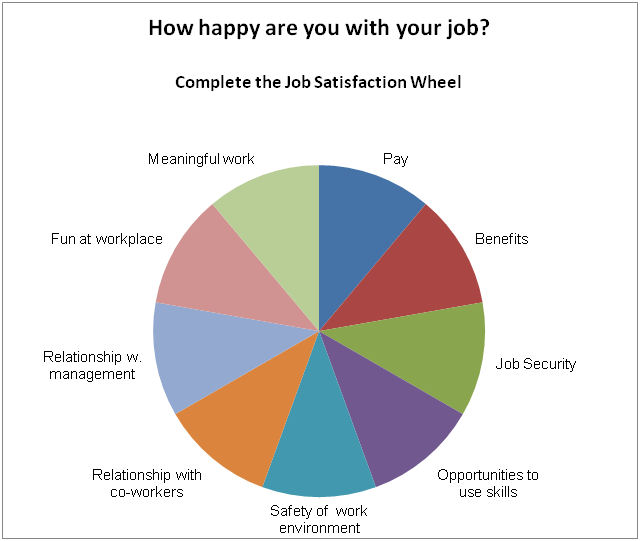Written on Tuesday, April 19th, 2011 at 4:13 pm by Christiane
It pays off to have job training in math, science or computer software engineering. According to a new job ranking by CareerCast, a job listing and research site, these professions are the best jobs in 2011 based on income, job prospect/ job security, stress level and work environment:
Top ranked is software engineer, followed in order by mathematician, actuary, statistician, computer systems analyst, meteorologist, biologist, historian, audiologist, and dental hygienist.
The worst jobs are: roustabout as the worst, followed by iron worker, lumberjack, roofer, taxi driver, EMT, welder, painter, meter reader, and construction worker.
Of course, the ranking criteria used by CareerCast are rather superficial as job satisfaction does not depend solely on salary, job stress or work environment. For most people, other factors are important too: Opportunities to learn, relationships with co-workers and management, career advancement options, feeling appreciated……
Also not considered in the ranking: individual aptitudes and personalities. For some people, software engineer may indeed be the best job ever; for others however, it may be the worst.
Find out what would be the best job for you based on your interests and needs – read my eBook
Written by Christiane. She is psychologist and Life & Career coach. Contact her at ten.u4hcaocnull@enaitsirhc
Tags: actuary, audiologist, biologist, career, career advancement, career coaching, co-workers, coaching, computer systems analyst, construction worker, dental hygienist, emt, historian, income, iron worker, job prospect, job satisfaction, job security, lumberjack, mathematician, meter reader, meterologist, painter, profession, relationship with co-workers, relationship with management, roofer, roustabout, salary, software engineer, statistician, taxi driver, welder, work environment, worst job
 1 Comment
1 Comment »
Written on Tuesday, July 27th, 2010 at 12:42 pm by Christiane
US employees get on average per year 9 days paid leave and 6 paid holidays – despite the fact that the US is the only advanced economy in the world that has no paid leave law. European workers, for comparison, get in minimum 20 days of paid leave in addition to paid holidays. In my native country Austria, workers can get even up to six weeks of paid leave plus 13 holidays.
In the US, full time employees and those with a higher income are more likely to get paid vacation days than part-time and low wage workers. And despite having on average only nine days of paid vacation, roughly a third of employees with vacation benefits don’t take all of the vacation days they receive. Many believe that management perceives it negatively if they take vacation. A typical fear in these days of high unemployment is that workers are afraid that they may get replaced if they don’t give 110 % and therefore they rather forego on the well deserved time-off. About 25% of those, who do take vacation, stay connected with their company by checking work email or taking phone calls from the office while on vacation. About one third of employees admitted in an Expedia.com survey that they feel guilty about taking time off.
They shouldn’t – because it’s not only in their own interest if they use their vacation days to relax and refresh. There’s also a benefit to the employer: Workers who don’t get a break will become exhausted and burned-out over time. They are no longer able to perform to their full potential. They are also at risk for depression and other health issues, which may end up to cost the company more than the vacation days. On the other hand, workers who come back after a break with new energy and new perspectives and ideas will be more productive.
Therefore, talk to your employer about your vacation needs and how the company can even benefit from it. Plan ahead and talk to your co-workers about your vacation. Ask a co-worker to cover for you if necessary and offer the same favor in return. Final advice: don’t take work with you and avoid checking emails. It’s quite unlikely that your office will fall apart just because you take a few days off.
And with these lines, I say “Good bye” for two weeks. I will be on vacation in Austria!
Christiane is a Life and Career Coach. She also teaches psychology at a community college in Massachusetts. You can reach her via her website http://www.coach4u.net or email her.
Tags: burn-out, burned out, burnout, career, career coach, checking email while on vacation, coach, coaching, European vacation law, getting replaced, job exhaustion, job satisfaction, job security, life coach, paid holiday, paid leave, productivity, secure workplace, US vacation law, Vacation, work, working during vacation
 1 Comment
1 Comment »
Written on Tuesday, July 20th, 2010 at 8:14 pm by Christiane

The ten sections of the Job Satisfaction Wheel represent important factors, which for many people determine job satisfaction.
 Print the wheel. Seeing the center of the wheel as 0 and the outer edges as 10, assign each section a value between 0 and 10, depending on YOUR satisfaction with the particular factor at YOUR current workplace. If you connect these values with a straight or curved line to create a new outer edge, do you still have a nice, round wheel?
 If you see areas that need improvement, take action. Don’t accept a dissatisfying job situation! Call me at 781 777 2791 or email me to schedule a Free Coaching introduction session to find out how Career Coaching can help you.
 Read also my e-workbook “Learn to Love your Job” with information and activities designed to help you to find satisfaction in your job. Learn more about the book.

Tags: benefits, boss, career coach Christiane Turnheim, career coaching, coaching, coaching sessions, compensation, eWorkbook learn to love your job, fun at workplace, hate my boss, job satisfaction, job security, meaningful work, opportunities to use skills, pay, relationship with co-workers, relationship with management, safety of work environment, satisfaction factors, satisfaction wheel, supervisor
 Comments
Comments »
Written on Wednesday, June 16th, 2010 at 4:20 pm by Christiane
What are the key factors that keep people happy in the workplace?
One would assume that this should be an easy question to research, however studies about this topic yield different results. For one, researchers use different questions in their surveys. Another reason is that not all studies analyze the results by age groups. Generally, younger workers tend to be less satisfied with their jobs than older workers and they do have different expectations.
The Society for Human Resource Management (SHRM) annually surveys employees and HR professionals about job satisfaction.
The Top 5 Job Satisfaction Factors for Employees are according to the 2009 Survey report :
- Job Security
- Benefits
- Compensation/Pay
- Opportunities to use skills and abilities
- Feeling safe in the work environment
The HR professionals in this study agreed with ‘ Job Security’ as top priority, and they also included ‘Benefit’s and ‘Opportunities to use skills and abilities’ among the top 5 factors. However, on rank 2 they put ‘Relationship with immediate supervisor’ and on rank 4’Ccommunication between employees and senior managemen’t.
Salary.com Inc.  found that employers overestimate the job satisfaction levels of their employees. According to the 2008/2009 Employee Satisfaction and Retention Survey by salary.com, about 65 % of employees said that they are somewhat satisfied with their jobs. Employers believed this number to be 77%. Â
Key Factors for staying in the job are according to the study:Â
Good relationships with co-workers, job security, desirable commute and desirable hours.  Good relationships with managers and adequate benefitswhere this time not among the top reasons why people remain in their jobs.
Top reasons to leave a job are according to the survey inadequate pay, insufficient recognition and not  enough development opportunities.
In my college classes, I usually give my students also a questionnaire about important job satisfaction factors. Most of my students are in their 20s, which means they belong to the group of the most unhappy workers in the US – at least according to the results of most  major surveys.
The top 5 key factors for job satisfaction according to my students are:
- Pay
- Benefits
- Relationship with supervisor
- Relationship with co-workers                             and, normally not included in surveys
- Humor/ having fun at the workplace
Perhaps this is the difference between todays young people and the rest of us workers. Young people want to enjoy the time they spend at work, while previous generations are more achievement oriented or only work to make a living.
Why do you work? What are the most important key factors for you? What motivates you? What can you do to improve a dissatisfying job?
Find the answers in my new eWorkbook: Job Satisfaction – Learn to Love Your Job!

This is not just another book to read. Activities like thought questions, questionnaires and exercises will guide you to a better understanding of your wishes and needs at the workplace. You will learn which aspects of your job are gratifying and which aspects need improvement. I also offer you advice and tips what you can do to improve your job situation.
Get the eWorkbook  “Job Satisfaction – Learn to Love Your Job” NOW!
Tags: benefits, career, career management, co-workers, commute, create job satisfaction, job satisfaction, job security, key factors for job satisfaction, opportunities to growth, opportunity to develop, pay, recognition, relationship with management, relationships with co-workers, salary
 7 Comments
7 Comments »
Written on Wednesday, January 6th, 2010 at 6:32 pm by Christiane
The majority of the American workforce is currently unhappy at work. Surprisingly, this situation seems to be not even directly related to the recession. There has been a 4% drop in job satisfaction just between 2008 and 2009, but annual surveys by the Conference board research group have shown a steady downward trend: 20 years ago more than 60 % of workers were satisfied with their jobs, today only about 45% of those surveyed expressed satisfaction.
The youngest workers are particularly unhappy: Only about 36% are satisfied with their job.
There are several reasons for the growing dissatisfaction:
According to the survey, workers find the work itself less interesting. Further, the satisfaction with job security is down – no wonder with an unemployment rate of about 10 %. Rising costs of living and health care are also to blame as many workers had to accept a cut in income when companies downsized production and work hours.
Christiane Turnheim is psychologist, college teacher and Life & Career coach. Contact her at ten.u4hcaocnull@enaitsirhc
Tags: american workers, american workforce, amp, career coach, college teacher, dissatisfaction, health care, interesting work, job satisfaction, job security, jobs, life coach, psychologist, recession, research group, surveys, unemployment rate, unhappy at work, unhappy with job
 Comments
Comments »

 1 Comment
1 Comment 

